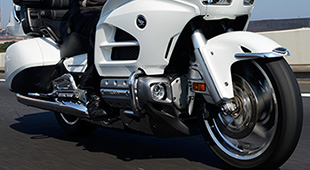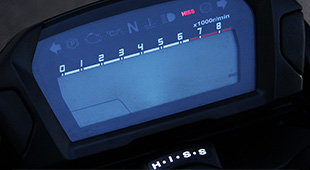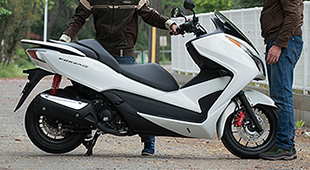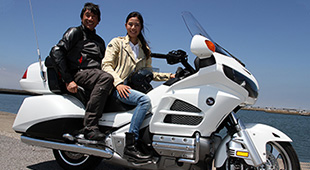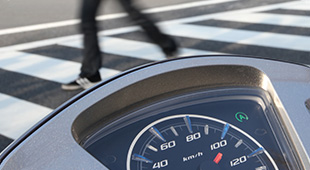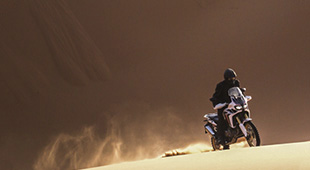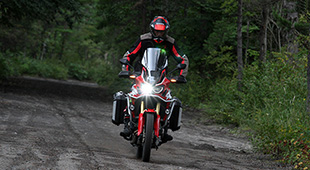Tech Views — Vol.1 Dual Clutch Transmission
CTX (Dual Clutch Transmission)

CTX (Dual Clutch Transmission)
Riding the New CTX, I Discovered For the First Time the True Depth and Breadth of the Dual Clutch Transmission
Recently I had a chance to ride Honda's new performance cruiser, the CTX700N, which features Honda's innovative Dual Clutch Transmission. The CTX's styling incorporates bold lines that parallel the road, much like the design featured on the latest Gold Wing, giving the impression that linear surfaces represent a new wave in cruiser design. Embodied in this new look are all the features one might associate with a cruiser, including a low stepped seat height, highway pegs positioned for a more extended reach, and pull-back handlebars. I discovered that much of the CTX's appeal lies in its use of unconventional methods to achieve a familiar look, such as its combination of linear lines and rounded surfaces, its teardrop-shaped fuel tank, and the sense of massiveness imparted by its discreet use of chrome.
Settling onto the Dual Clutch Transmission CTX700N, one of the first things you notice is that the bike has no traditional shift lever positioned in front of its left-side foot peg. The reason, of course, is that the Dual Clutch Transmission performs all shifting duties automatically, and starting out is certainly made easy because of it. Once the engine is started and the parking brake is released, simply toggling the right-side thumb switch from N (Neutral) to D (Drive) puts the bike in traveling mode. At this point, all it takes to get the CTX moving is a twist of the throttle.
I soon found that being able to ride the CTX in urban traffic using only the throttle and brakes was a great advantage. You might think that this is because of its automatic transmission, but you'd be mistaken. Mechanically, the Dual Clutch Transmission is still fundamentally a manual transmission, but with oil pressure smoothly performing all the actual gear shifting operations in place of the rider by way of two separate clutch packs secreted under the same cover. Because of this, even relative novices can achieve shifting operation on par with a highly experienced pro.
However, if you prefer more personal control over the transmission's 'manual' operation, an easy press of the left-side Up (+) and Down (-) switches instantly enables clutch and shifting operations. The true performance potential of Honda's unique Dual Clutch Transmission can really be felt here in its automated manual operation.
The sensation I got riding the CTX was that the strong cruiser power delivery I fully expected was further enhanced and in a way made fresher and more cruiser-like than what I had earlier experienced riding Honda's other Dual Clutch Transmission-equipped models, like the two midrange NC700 sports bikes and the top-of-the-line VFR1200F and VFR1200X Crosstourer. The CTX's engineers seemed to have improved the engine's connection with the clutch, especially at that critical instant when starting out from a stop. The result is a more visceral feel of the engine's torquey power pulses accompanied by its stirring rumble of acceleration, which give it more of the impression of an 'old school' cruiser.
Gear change operation, particularly up from low to second, was accompanied by a truly satisfying sense of powering up through the gears. You can tell that Honda's engineers really strove to achieve this feel, and the sensation is truly tasty. I'm sure I'm not alone in this, but when riding a cruiser I tend to shift quickly from first to second without really raising the revs much, then I open up the throttle for a bit to get a feel of the engine's power pulses through the frame before clicking up to third. The CTX's Dual Clutch Transmission manages to mimic this uniquely cruiser-like acceleration in way that's truly impressive.
Another thing I noted when cruising slowly in Drive mode, was that cracking open the throttle in fifth gear didn't result in a quick automatic downshift accompanied by an abrupt burst of higher revs. Instead, it let me enjoy the rumbling torque-filled acceleration of low revs powering up to speed, and further allowed me to enjoy the ride around town while minding the speed limits. This pleasure I thought was reserved for larger cruisers pulling their heavier loads with bigger-displacement engines. However, the CTX, with its Dual Clutch Transmission, really allowed me to enjoy this exhilarating aspect of cruiser riding..
"This is it!," I thought, and continued my ride in a happy state of mind.
Basically, this is a significant part of what differentiates the Dual Clutch Transmission from conventional automatic transmissions. The Dual Clutch Transmission automatically performs a normal manual transmission's clutch and shifting operation.
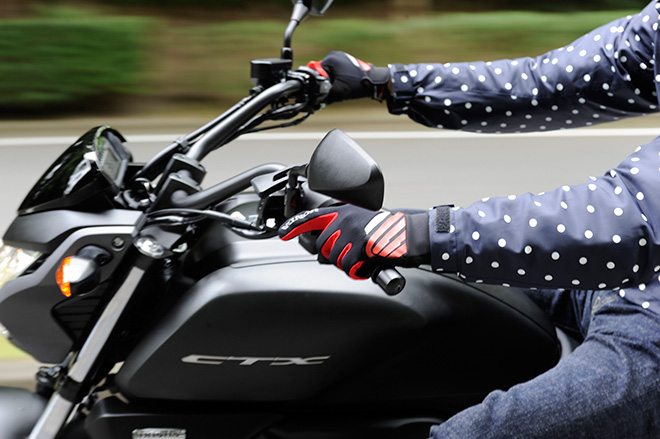
It also freed me from any sense of uneasiness about making mistakes in clutch operation, or misjudging engine speed. This enabled me to thoroughly enjoy pleasant starts and smooth, seamless shifts-both up and down-that rival the best gear-changing operation I'm capable of. I was also astonished to note how much wider a rider's breadth of awareness can be expanded when simply relieved of the distractions of matching clutch and throttle operation while jiggling a lever with one's foot.
Out of town, the CTX traces winding roads with a lightness of handling that accentuates the calm, stable corning control you'd expect of the best cruisers. A twist of the throttle easily brings out its full performance potential, and you can be sure it won't be left behind when traveling with the sports bike crowd. Without the minor distractions of changing gears, I found I could also concentrate more on the more important basics of acceleration, braking and following my chosen line, giving me a greater feeling of freedom and riding capability. In fact, it would be no exaggeration to say that the CTX's engine performance and handling combine with the smooth, seamless operation of its Dual Clutch Transmission to fill any rider' heart with a satisfying feeling of freedom and enhanced riding ability.
Unlike a car, riding a motorcycle generally involves the rider's entire body. One of the CTX's great advantages is that by eliminating the need to operate the clutch with the left hand and gear shifter with the left foot, it leaves the mind free to concentrate more on the ride, with manual operation limited to the right hand's control of the throttle and front brake, and the right foot's operation of the rear brake.
What's really new is the ability to enjoy the distinctive character of a large cruiser while at the same time having at one's fingertips the high functional capabilities of a sports bike. I felt that the Dual Clutch Transmission really added to the CTX's overall riding appeal by emphasizing the strong points of the engine's robust torque. This was especially evident in the 3,500 to 5,000rpm range, and to such an impressive extent then I caught myself wondering if this was really a 700cc bike, or if the displacement had somehow been increased. The combination of the CTX and its Dual Clutch Transmission really makes this a prominent feature.
When Honda's first Dual Clutch Transmission models appeared, some folks complained that "automatic clutch operation will have a degenerative effect on rider capabilities." At first I wondered if that might be true, but now, after some experience, I really have to strongly disagree. Rather, I believe this system will help riders evolve, since all the attention normally required for correct gear shift operation can now be better focused on the overall riding experience; the beauty of the scenery, the sounds and smells carried by the wind, the sense of discovery in the lands being traveled, and even chatting with a passenger. My feeling is that the Dual Clutch Transmission offers a sense of release that adds vast depth to one's motorcycle riding life.
No, the Dual Clutch Transmission is not merely a device for making operation easier, it is also a tool for helping one more fully enjoy the riding life.

In keeping with the CTX's custom cruiser character, the cover of the Dual Clutch Transmission also features a distinctively cool design.
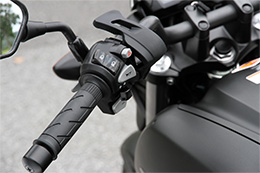
No clutch lever on the left-side handlebar. Instead, a large thumb shift switch located under the indicator switch provides instant downshifts. The CTX also comes equipped with a handy parking brake.
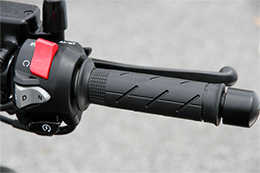
The A (Automatic)/M (Manual) mode selector switch is located on the right-side handlebar switch module, and the gray shift selector thumb switch toggles between N (Neutral), D (Drive) and S (Sport) shift modes.
TRANSMISSION TECHNOLOGIES - DUAL CLUTCH TRANSMISSION -
Honda has developed a motorcycle transmission with automated clutch and shift operation that delivers the same riding enjoyment as a manual transmission.

